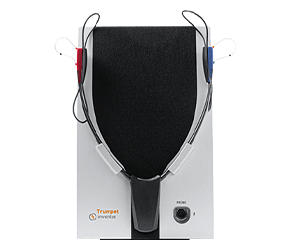Frequency lowering verification with Inventis Trumpet
There is an occurrence of hearing loss, in a small percentage of the population, so severe in the higher frequencies that it does not allow recovering of speech intelligibility through simple amplification. In these cases it is possible to utilize hearing aids that provide a frequency lowering functionality.
Basically, frequency lowering shifts the sound from one pitch to a lower one, to make speech sounds more audible. Age-related and noise-induced hearing loss occurs mostly in high frequencies. Actually, as we age, the ability of hearing high frequency sounds is progressively lost. Unfortunately, in many languages a significant portion of the sounds needed to understand speech have a frequency equal to or greater than 3000 Hz (e.g. speech sounds like “f”, “s”, “th”), which means that their audibility will be compromised in the case of age-related hearing loss. A simple amplification of the frequencies associated with these speech sounds would make the signal unclear, due to the distortions that can occur in the ear.
With the use of frequency lowering, instead of being over-amplified, the higher frequencies are shifted to a lower frequency region, where they can be heard with less amplification, and less distortion. Different methods of frequency lowering exist: they can be based on modulation, compression or signal transposition.
Depending on the technique implemented in the hearing aid used, the sound will be played in different ways. For example, frequency lowering based on signal compression, rather than transposing techniques, does not maintain the starting relationship between the different harmonics, which is potentially bothersome if the patient is used to listening to music. This tradeoff may be worth it, depending on the individual.
When verifying the fitting of a hearing aid with the REM system Inventis Trumpet, after adjusting the hearing aid gains, it is possible to check its frequency lowering functionality. The initial curve should be acquired, with the patient wearing the hearing aid switched on, but with frequency lowering disabled; given the type of hearing loss of the patient, it is expected that at the high frequencies a good part of the signal falls out of the region that represents the area of audibility of the subject. Then the frequency lowering is activated and a new curve recorded using the same stimulus as in the region previous step. The signal spectrum is expected to be modified, in such a way that some of the information previously represented at high frequencies is now contained in a lower frequency region.



 Ir al inicio
Ir al inicio

 International - English
International - English Italia - Italiano
Italia - Italiano France - Français
France - Français USA - English
USA - English